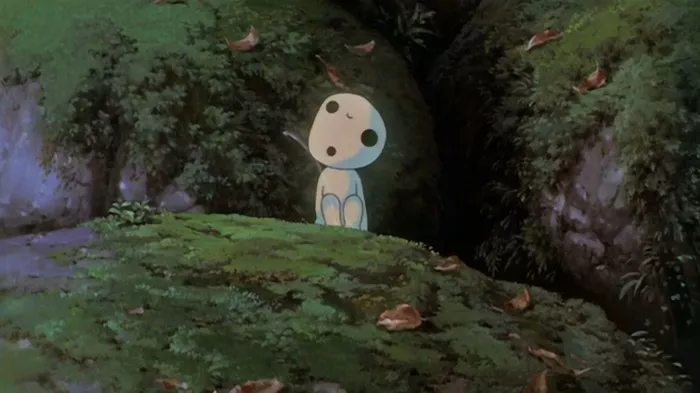Princess Mononoke (1997), directed by Hayao Miyazaki and produced by Studio Ghibli, is a film renowned for its deep environmental themes, complex characters, and stunning animation. Among its many captivating elements, the little spirits—often referred to as kodama or tree spirits—play a unique and significant role. This article explores the various aspects of these little spirits, their symbolic meanings, their role in the narrative, and their impact on the film’s themes and audience.
The Little Spirits
The little spirits in Princess Mononoke are a type of forest spirit that populates the world Miyazaki has created. They appear as small, ethereal creatures that embody the natural world. Their design is minimalistic yet evocative, with their simplistic, ghost-like forms contributing to the film’s ethereal and otherworldly atmosphere.
Appearance and Characteristics
The kodama are often seen as tiny, translucent figures with large, expressive eyes and a round, almost doughnut-like body. They have a ghostly quality, floating effortlessly through the forest. Their appearance is deliberately designed to evoke a sense of fragility and innocence, underscoring their connection to nature.
These spirits are characterized by their glowing white appearance and the distinctive, hollow sounds they emit. The kodama are usually depicted with a calming, otherworldly glow that enhances their mystical aura. They are often shown interacting with their environment in subtle ways, such as gently swaying or glowing in response to changes in their surroundings.
Symbolism of the Little Spirits
The little spirits in Princess Mononoke are rich in symbolism and serve multiple purposes within the narrative. Their most prominent symbolism is their representation of nature and its purity.
Representation of Nature
The kodama are direct manifestations of the forest’s vitality and purity. They symbolize the essence of the natural world, untouched by human influence. Their presence in the film serves as a reminder of the forest’s health and the interconnectedness of all living things within it.
Harbingers of Change
The kodama also act as harbingers of change and indicators of environmental shifts. Their behavior often reflects the state of the forest. For example, when the forest is threatened or disturbed, the kodama become agitated or disappear, signaling the impending damage. This connection underscores the delicate balance between humans and nature and the consequences of disrupting that balance.
See Also: Is Princess Mononoke Good?
Themes of Innocence and Fragility
The kodama embody the themes of innocence and fragility. Their small size and ghostly appearance evoke a sense of vulnerability. They are highly sensitive to changes in their environment, making them symbols of the fragile and easily disrupted state of nature. This fragility is a key element in the film’s exploration of environmental issues and the consequences of human actions.
Role in the Narrative
The little spirits play a crucial role in the narrative of Princess Mononoke. They contribute to the film’s atmosphere, provide insight into the state of the forest, and reflect the broader themes of environmentalism and human impact.
Atmospheric Contribution
The kodama contribute significantly to the film’s atmosphere. Their ethereal presence and haunting sounds enhance the mystical and otherworldly quality of the forest. This atmosphere immerses the audience in the magical and enigmatic world that Miyazaki has created.
Indicators of Environmental Health
In the film, the kodama serve as indicators of the forest’s health. Their appearance or disappearance often corresponds with the state of the forest. When the forest is thriving, the kodama are abundant and active. Conversely, when the forest is in distress, the kodama become scarce or vanish. This use of the kodama as environmental indicators reinforces the film’s message about the impact of human activities on nature.
Reflection of Themes
The kodama also reflect the film’s broader themes, including the conflict between industrialization and nature, the consequences of human actions, and the importance of respecting the natural world. Their vulnerability and connection to the forest underscore the film’s central message about the need for harmony between humans and the environment.
Impact on the Audience
The little spirits have a profound impact on the audience, both emotionally and thematically. Their gentle and enigmatic presence evokes a sense of wonder and connection to the natural world.
Emotional Response
The kodama evoke an emotional response from the audience through their delicate and mysterious nature. Their ghostly appearance and the soft, otherworldly sounds they produce create a sense of tranquility and nostalgia. This emotional impact helps to deepen the audience’s engagement with the film and its themes.
Thematic Resonance
The thematic resonance of the kodama is significant. They embody the film’s environmental message and contribute to its exploration of the relationship between humans and nature. By presenting the kodama as symbols of the forest’s health and vitality, Miyazaki effectively communicates the importance of preserving the natural world.
Conclusion
The little spirits in Princess Mononoke are a vital and symbolic element of the film. Their ethereal appearance, connection to nature, and role in the narrative contribute to the film’s atmospheric and thematic depth. Through their delicate presence, the kodama underscore the film’s message about the fragility of nature and the importance of respecting and preserving the natural world. Princess Mononoke remains a powerful exploration of environmental themes, and the little spirits play a crucial role in conveying this message. Their presence in the film is a testament to Miyazaki’s ability to blend visual storytelling with deep, meaningful themes, creating a work that resonates with audiences on multiple levels.


